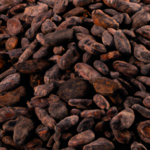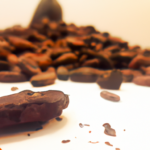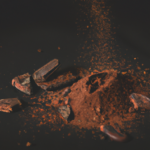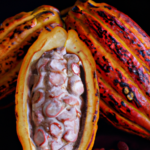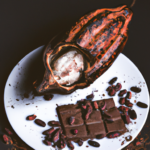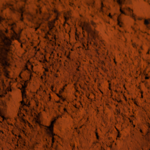Raw Food Ingredients
What Do Raw Cacao Beans Taste Like
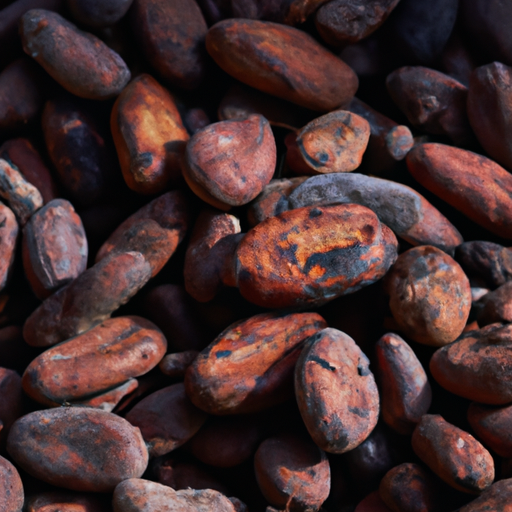
As a chocolate enthusiast, I have always been fascinated by the flavor of raw cacao beans. I often ponder what it would be like to savor the unaltered essence of these marvelous beans.
Raw cacao beans are said to have a unique and complex taste, unlike anything else. They are known for their rich, deep chocolate flavor, with hints of fruity and nutty undertones. Some describe it as slightly bitter, yet pleasantly sweet. The taste is often compared to dark chocolate, but with a more intense and earthy profile.
I can’t help but imagine the burst of flavors that would dance on my tongue when I bite into a raw cacao bean. In this article, we will delve into the fascinating world of raw cacao beans and explore their flavor in detail.
So, let’s embark on this delicious journey and discover what raw cacao beans truly taste like.
Key Takeaways
- Raw cacao beans have a unique and complex taste with a rich, deep chocolate flavor.
- They have hints of fruity and nutty undertones and are slightly bitter, yet pleasantly sweet.
- Compared to dark chocolate, raw cacao beans have a more intense and earthy profile.
- The taste of raw cacao beans can be transformed through different harvesting and fermenting methods.
The Origins of Raw Cacao Beans
The origins of raw cacao beans can be traced back thousands of years to ancient civilizations in Mesoamerica. The history of cacao cultivation is fascinating, as it holds great cultural significance for these civilizations. Cacao beans were highly valued and considered a sacred food, used in religious ceremonies and as currency. The Mayans and Aztecs believed that cacao possessed mystical powers and even used it as a form of medicine.
The process of harvesting and fermenting cacao beans played a vital role in unlocking their rich flavors and transforming them into the chocolate we know today. This process involves carefully harvesting the ripe cacao pods, extracting the beans, and allowing them to ferment. Once fermented, the beans are then dried and roasted to enhance their unique taste and aroma.
The Process of Harvesting and Fermenting Cacao Beans
When you harvest and ferment cacao beans, you’ll witness the transformation of their flavors, resulting in a rich and complex taste reminiscent of earthy, fruity, and nutty notes.
The harvesting techniques play a crucial role in determining the quality of the beans. Ripe cacao pods are carefully cut from the tree using a machete or a specialized tool, ensuring minimal damage to the beans inside.
The fermentation process is equally important, as it brings out the unique flavors of the cacao beans. The harvested beans are placed in shallow fermentation boxes or wrapped in banana leaves and left to ferment for several days. This process allows the beans to develop their characteristic flavor and aroma.
The subsequent section will delve into the unique flavor profile of raw cacao beans, showcasing their true potential.
The Unique Flavor Profile of Raw Cacao Beans
The flavor profile of raw cacao beans is truly one-of-a-kind. Its rich and complex taste evokes notes of earthiness, fruitiness, and nuttiness.
When you bite into a raw cacao bean, you’ll first experience a deep, earthy flavor reminiscent of dark chocolate. As you continue to chew, subtle hints of fruity undertones emerge, like berries or even tropical fruits.
The finish is where the nuttiness comes in, leaving a pleasant and slightly bitter aftertaste on your palate.
These flavor notes make raw cacao beans a versatile ingredient in culinary uses. They can be ground into a powder and added to smoothies, baked goods, or even used as a topping for desserts.
Transitioning into the next section, let’s explore how to enjoy the unique taste of raw cacao beans in different ways.
How to Enjoy Raw Cacao Beans
To fully savor the unique flavors of raw cacao beans, you can indulge in various delectable treats that showcase their rich and complex taste. Here are four ways to enjoy the benefits of eating cacao beans and explore the world of cacao bean recipes:
-
Raw Cacao Smoothie: Blend raw cacao beans with ripe bananas, almond milk, and a touch of honey for a creamy and nutritious treat.
-
Raw Cacao Energy Balls: Combine raw cacao beans, dates, nuts, and coconut flakes in a food processor, roll into bite-sized balls, and refrigerate for a quick and energizing snack.
-
Raw Cacao Bark: Melt raw cacao beans, mix in dried fruits, nuts, and seeds, then spread the mixture on parchment paper and let it set. Break into pieces for a guilt-free chocolatey treat.
-
Raw Cacao Hot Chocolate: Whisk ground raw cacao beans with hot milk, a dash of vanilla extract, and a sprinkle of cinnamon for a cozy and indulgent beverage.
By exploring these cacao bean recipes, you can unlock the full potential of their flavors and experience their numerous health benefits.
Now, let’s delve into the subsequent section about the health benefits of raw cacao beans.
The Health Benefits of Raw Cacao Beans
Raw cacao beans offer numerous health benefits that make them a valuable addition to any diet.
Firstly, they are high in antioxidants, which help protect the body against free radicals and oxidative stress.
Additionally, raw cacao beans are a good source of essential minerals such as magnesium, iron, and zinc, which are important for various bodily functions.
Lastly, these beans have the potential to boost mood due to their rich content of phenylethylamine, a compound that may enhance feelings of happiness and well-being.
High in Antioxidants
Cacao beans are bursting with antioxidants, making them a powerful source of nutrition. These antioxidants play a crucial role in protecting our bodies from free radicals, which can cause damage to our cells and lead to various health issues. Raw cacao beans contain a high concentration of antioxidants, such as flavanols and polyphenols, which have been linked to numerous health benefits.
These include reducing inflammation, improving heart health, and even enhancing brain function.
Incorporating raw cacao beans into your diet can be done in various ways. You can use them in raw cacao bean recipes, such as adding them to smoothies, baking them into cookies, or even making your own healthy chocolate treats. By doing so, you not only enjoy the rich and intense flavor of cacao but also reap the benefits of antioxidants.
Moving on to the next section about the benefits of cacao as a good source of essential minerals…
Good Source of Essential Minerals
After discussing the high antioxidant content of raw cacao beans, let’s now explore their status as a good source of essential minerals.
These beans are not only packed with antioxidants, but they also offer a wide range of minerals that are vital for our overall health.
One of the key benefits is their positive impact on cardiovascular health. The minerals found in raw cacao beans, including magnesium and potassium, promote healthy blood flow and help maintain normal blood pressure levels.
Additionally, these minerals are beneficial for bone health, as they contribute to the development and maintenance of strong bones.
So, incorporating raw cacao beans into your diet can be a great way to support your cardiovascular system and improve bone strength.
Moving forward, let’s delve into the potential mood-boosting effects of these incredible beans.
Potential Mood-Boosting Effects
Indulging in these magical little nuggets can uplift your spirits and send your happiness soaring to new heights.
Raw cacao beans have been found to have mood-boosting properties, according to scientific research. They contain compounds like phenylethylamine (PEA) and anandamide, which are known to promote feelings of joy and relaxation.
PEA is a natural compound that acts as a neurotransmitter in the brain, helping to improve mood and increase focus. Anandamide, often referred to as the ‘bliss molecule,’ has been linked to feelings of euphoria and overall well-being.
So, when you enjoy a bite of raw cacao, you’re not only treating yourself to a delicious snack, but you’re also giving your mood a little boost.
Now, let’s explore the differences between raw cacao beans and processed chocolate.
Raw Cacao Beans vs. Processed Chocolate
When comparing raw cacao beans to processed chocolate, you can easily notice the stark difference in taste. Raw cacao beans have a rich, slightly bitter flavor with hints of fruitiness and nuttiness. Processed chocolate, on the other hand, is often sweeter and smoother due to the addition of sugar and other ingredients. However, the taste is not the only difference between the two. Raw cacao beans are highly nutritious, packed with antioxidants, magnesium, and iron. They also contain a compound called theobromine, which can have mood-boosting effects. Processed chocolate, although it may not have the same nutritional benefits as raw cacao beans, still offers some health benefits, especially if it has a high percentage of cocoa. It can improve heart health and provide a source of antioxidants. So, if you’re looking for a healthier option, raw cacao beans are the way to go. Now, let’s talk about where to find raw cacao beans.
Where to Find Raw Cacao Beans
To get your hands on raw cacao beans, you can head to specialty health food stores or check out local farmers markets. Here are some key places to look for these delicious beans:
-
Cacao Farms: Visit cacao farms in your area or travel to regions known for their cacao production. This is a great way to support local farmers and experience the process firsthand.
-
Online Suppliers: Many online stores specialize in selling raw cacao beans. This option offers convenience and access to a wider variety of beans from different regions.
-
Co-ops and Community Supported Agriculture (CSA): Joining a co-op or CSA program can provide access to organic and sustainably sourced raw cacao beans. It’s a great way to support local agriculture and connect with like-minded individuals.
-
Directly from Manufacturers: Some manufacturers sell raw cacao beans directly to consumers. This ensures freshness and allows you to learn more about their sourcing and production practices.
Finding raw cacao beans allows you to reap the benefits of consuming this superfood. Now, let’s explore some tips for buying and storing these precious beans.
Tips for Buying and Storing Raw Cacao Beans
If you’re on the hunt for raw cacao beans, here are some handy tips for purchasing and storing these coveted treats.
- When buying raw cacao beans, look for beans that are organic and fair trade certified. This ensures that you’re getting a high-quality product that was ethically produced.
- Check the beans for any signs of mold or damage, as this can affect the flavor and quality.
As for storage:
- Keep your raw cacao beans in an airtight container in a cool, dark place.
- Avoid exposing them to light, heat, or moisture, as this can cause them to spoil.
By following these buying tips and storage recommendations, you can enjoy the rich and flavorful world of raw cacao bean varieties.
Exploring the World of Raw Cacao Bean Varieties
When it comes to raw cacao beans, there is a whole world of varieties to explore.
Single-origin beans are known for their unique flavors that are influenced by the specific region where they are grown.
Different cacao bean strains also contribute to the diversity of flavors, with some strains being more fruity, while others are more nutty or even floral.
And for those looking for something truly special, there are rare and exotic varieties that offer a truly unique and unforgettable taste experience.
Single-Origin Beans
Single-origin cacao cultivation is the practice of growing cacao beans in specific regions, allowing them to develop distinct flavors based on their unique terroir. Imagine biting into a single-origin cacao bean and experiencing an explosion of rich, intense flavors that dance across your taste buds.
The flavor variations in single origin beans can be quite remarkable. For example, beans grown in Madagascar may have fruity and acidic notes, while those from Ecuador might have a floral and nutty flavor profile. Each origin offers a different taste experience, making it exciting to explore the world of single-origin cacao beans.
As we delve into different cacao bean strains, we will discover even more fascinating nuances in flavor and aroma.
Different Cacao Bean Strains
Exploring different cacao bean strains reveals a captivating array of flavors and aromas. Each strain offers a unique and intriguing taste experience. The flavors of cacao beans can vary greatly depending on the strain and cultivation techniques used.
Some strains have a fruity and acidic flavor profile, reminiscent of berries or citrus fruits. Others may have a more nutty and earthy taste, with hints of caramel or roasted nuts. The cultivation techniques, such as the climate, soil conditions, and fermentation process, also play a significant role in determining the flavor of the beans.
These factors contribute to the diversity of cacao bean flavors, making each strain a fascinating exploration of taste sensations.
Moving on to the subsequent section about ‘rare and exotic varieties,’ we delve deeper into the world of extraordinary cacao bean flavors.
Rare and Exotic Varieties
Rare and exotic cacao bean varieties offer a tantalizing array of flavors and aromas. Each strain provides a unique and intriguing taste experience. These rare cacao flavors come from cacao beans grown in specific regions and processed using unique techniques.
One such variety is the Porcelana cacao bean. It is known for its delicate floral notes and smooth texture. Another rare variety is the Criollo cacao bean. It is often described as having a complex flavor profile with hints of fruit, nuts, and spices. The Nacional cacao bean, grown in Ecuador, offers a rich and robust flavor with notes of coffee and caramel.
These rare cacao varieties are highly sought after by chocolate makers and connoisseurs for their distinct flavors and exceptional quality. The unique cacao processing techniques used for these beans contribute to their exceptional taste, making them a true delight for chocolate lovers.
Frequently Asked Questions
Are raw cacao beans bitter in taste?
Yes, raw cacao beans are naturally bitter in taste. However, they also offer numerous health benefits. They are rich in antioxidants, promote heart health, improve mood, and provide essential minerals like magnesium and iron.
Can raw cacao beans be eaten as a snack on their own?
Raw cacao beans can be enjoyed as a snack on their own. They provide numerous benefits, like boosting mood and providing antioxidants. Additionally, they can be added to smoothies, baked goods, or used in homemade chocolate recipes.
Do raw cacao beans have a similar taste to processed chocolate?
Raw cacao beans have a distinct flavor that is different from processed chocolate. They have a rich, bitter taste with fruity and nutty undertones. In addition to their unique flavor, raw cacao beans also offer numerous health benefits.
Can raw cacao beans be used as a substitute for cocoa powder in recipes?
Raw cacao beans can be a substitute for cocoa powder in baking. They have a rich, intense flavor and contain more antioxidants and nutrients than processed cocoa powder, making them a healthier choice.
Are there any side effects or precautions to consider when consuming raw cacao beans?
There are potential health benefits to consuming raw cacao beans, but it’s important to consider precautions. Excessive intake may lead to digestive issues, increased heart rate, and caffeine sensitivity. Recommended daily intake varies, so consult a healthcare professional.
What is the Taste of Raw Cacao Beans Compared to Processed Cocoa?
Raw cacao taste description is often described as more bitter and intense compared to processed cocoa. Raw cacao beans have a richer, more complex flavor with nutty and fruity undertones, while processed cocoa tends to be sweeter and less bold in taste.
Conclusion
In conclusion, raw cacao beans are a true delight for the senses. Their rich and complex flavor profile ranges from fruity to nutty and even floral. This symphony of taste will leave you craving more. These little beans may not look like much, but their power to transform into decadent chocolate is awe-inspiring.
So next time you come across raw cacao beans, don’t hesitate to indulge in their pure and unadulterated deliciousness. After all, life is too short to resist the allure of nature’s chocolate treasure.
Rachael, the Editor in Chief of RachaelsRawFood.com, is an inspiring and passionate individual who has dedicated her life to promoting the benefits of a raw food lifestyle. Known for her vibrant and energetic personality, Rachael has built a strong online presence that has transformed her personal journey into a thriving community of raw food enthusiasts.
Raw Food Ingredients
How Much Caffeine in Cocoa?
Not all cocoa products are created equal when it comes to caffeine content – discover which one might surprise you!

When evaluating the caffeine levels in cocoa, it’s important to recognize that dark chocolate contains around 43 mg of caffeine per 100 grams due to its high cocoa solid content. Dark chocolate has a higher caffeine content compared to milk or white chocolate. This means that consuming dark chocolate in moderation can assist in managing your caffeine intake. On the other hand, milk chocolate has around 20 mg of caffeine per 100 grams while white chocolate is caffeine-free. Cocoa powder, commonly used in baking and beverages, contains a substantial 230 mg of caffeine per 100 grams. Being aware of these distinctions in chocolates can help you make informed decisions about your caffeine consumption.
Key Takeaways
- Caffeine content in cocoa varies based on cocoa solid concentrations.
- Unsweetened cocoa powder can contain around 230 mg of caffeine per 100 grams.
- Roasting cocoa solids influences the final caffeine content in cocoa products.
- Dark chocolate, with high cocoa solid content, has more caffeine than milk chocolate.
- Moderate consumption of cocoa products helps manage caffeine intake.
Caffeine Content in Dark Chocolate
Dark chocolate boasts a caffeine content of approximately 43 mg per 100 grams, mainly deriving from its higher cocoa solid composition. When we indulge in this decadent treat, we aren't only savoring its rich cocoa flavor but also a subtle caffeine kick. Compared to milk or white chocolate, dark chocolate contains a higher amount of caffeine.
Please bear in mind that moderate consumption of dark chocolate can assist individuals in managing their caffeine intake effectively. The caffeine levels in dark chocolate are about one-fourth of what you'd find in a standard cup of coffee. So, if you're looking for a milder caffeine boost, a piece of dark chocolate might just do the trick without the jitters that sometimes accompany a strong cup of coffee.
Enjoy your dark chocolate in moderation, savoring both its taste and the gentle pick-me-up it provides.
Caffeine Levels in Milk Chocolate

Milk chocolate, known for its creamy texture and sweet flavor, contains a modest caffeine content of approximately 5.6 mg per ounce, as indicated by USDA data. Unlike dark chocolate, milk chocolate has a lighter color due to lower cocoa content, resulting in reduced caffeine levels.
The delightful creamy taste in milk chocolate comes from a harmonious blend of cocoa and milk powder. While dark chocolate boasts higher caffeine content, milk chocolate remains a popular choice for those seeking a sweet treat with minimal caffeine intake.
Caffeine Presence in White Chocolate
With its unique composition excluding cocoa solids, white chocolate stands out as a caffeine-free alternative to its darker counterparts. White chocolate is crafted from a blend of cocoa butter, milk powder, sugar, and vanilla, making it a delectable treat without the stimulating effects of caffeine. For individuals sensitive to caffeine, white chocolate offers a creamy texture and indulgent flavor without the worry of unwanted side effects. This makes it a popular choice for desserts among those looking to steer clear of caffeine in their sweet treats.
Compared to dark chocolate, which contains cocoa solids and hence caffeine, white chocolate provides a caffeine-free option for those seeking a more mellow indulgence. So, if you're in the mood for a luscious and smooth chocolate experience without the buzz of caffeine, white chocolate is the perfect choice for your next dessert delight.
Impact of Cocoa Solids on Caffeine

In determining the caffeine levels in cocoa products, the percentage of cocoa solids plays a significant role. Here are some key points about the impact of cocoa solids on caffeine content:
- Caffeine Derivation: The caffeine content in cocoa primarily comes from cocoa solids, making it an important factor in determining the overall caffeine levels in cocoa-based products.
- Dark Chocolate: Dark chocolate, known for its higher cocoa solid content, tends to contain more caffeine compared to milk or white chocolate varieties due to this higher concentration.
- Unsweetened Cocoa Powder: A 100g serving of unsweetened cocoa powder can contain around 230mg of caffeine, reflecting the impact of the high cocoa solid content in this form.
- Health Benefits: The roasting process of cocoa solids not only affects the flavor profile but also influences the caffeine content, contributing to the potential health benefits associated with consuming cocoa products like hot cocoa.
Comparing Caffeine in Different Chocolates
Comparing the caffeine content in different chocolates reveals varying levels based on their cocoa solid concentrations. Dark chocolate contains about 43 mg of caffeine per 100 grams, making it a stronger caffeinated option compared to milk chocolate, which only has around 20 mg per 100 grams.
Surprisingly, white chocolate, derived from cocoa butter, doesn't contain any caffeine at all. For those seeking a more potent caffeine kick, cocoa powder is the way to go, boasting a high concentration of 230 mg per 100 grams.
The amount of caffeine in chocolate products is closely linked to the cocoa solid content, with dark chocolate containing the highest levels. So, the next time you're craving a chocolate treat but also need a little energy boost, opt for dark chocolate to get the most caffeine per bite.
Frequently Asked Questions
Is There More Caffeine in Cocoa Than Coffee?
There's more caffeine in cocoa than in coffee. Cocoa powder packs 230 mg per 100 grams, surpassing most coffee varieties. Dark chocolate has even more caffeine due to higher cocoa content. It's a rich, unique energy source.
Is There a Lot of Caffeine in Hot Cocoa?
There isn't a lot of caffeine in hot cocoa. It depends on the brand and recipe. Starbucks hot chocolate has around 25 mg per serving, while basic mixes have about 5 mg. The amount of cocoa powder used influences the caffeine content.
Is There Caffeine in Hershey's Cocoa?
Absolutely, Hershey's Cocoa does contain caffeine, but it's not overwhelming. It adds a delightful hint of energy in each spoonful. Perfect for baking or a cozy cup of hot chocolate. Just the right amount!
Is Cocoa a Stimulant Like Caffeine?
Cocoa stimulates like caffeine due to its theobromine content. Decaf versions offer a solution for caffeine-sensitive folks. Options include regular cocoa with caffeine, Dutch-processed cocoa with less, and decaf cocoa with reduced caffeine while keeping healthful compounds.
What are the potential health effects of consuming high levels of caffeine in cocoa?
Unveiling cocoa caffeine levels can lead to potential health effects of excessive consumption. High levels of caffeine in cocoa may contribute to insomnia, nervousness, and fast heartbeat. It can also cause gastrointestinal discomfort and exacerbate anxiety disorders. Moderation in consuming caffeinated cocoa products is recommended for overall health.
Conclusion
To sum up, the caffeine content in cocoa varies depending on the type of chocolate. Dark chocolate typically has the highest caffeine levels, followed by milk chocolate and white chocolate. The amount of cocoa solids in the chocolate also affects the caffeine content.
Remember, just like different chocolates have different levels of caffeine, we all have unique strengths and abilities. Embrace your individuality and always aim for balance in everything you do.
Rachael, the Editor in Chief of RachaelsRawFood.com, is an inspiring and passionate individual who has dedicated her life to promoting the benefits of a raw food lifestyle. Known for her vibrant and energetic personality, Rachael has built a strong online presence that has transformed her personal journey into a thriving community of raw food enthusiasts.
Raw Food Ingredients
5 Key Differences: Caffeine Content in Cocoa Vs Coffee
Open the door to understanding the contrasting caffeine levels in cocoa and coffee, revealing surprising insights that will reshape your beverage choices.

When comparing the caffeine levels in cocoa and coffee, it is important to understand that cocoa generally has lower caffeine content than coffee. Dark chocolate contains approximately 12 milligrams of caffeine per ounce, while hot cocoa typically ranges from 5 to 10 milligrams per ounce. In contrast, brewed coffee can have significantly higher levels, varying from 95 to 165 milligrams per 8-ounce cup.
Cocoa is considered a milder option for individuals aiming to limit their caffeine intake, with theobromine providing a gradual energy increase. Meanwhile, coffee's caffeine content offers immediate alertness, and understanding these distinctions can help you select based on your preferred effects.
Key Takeaways
- Cocoa contains lower caffeine levels but compensates with theobromine for a gradual energy increase.
- Coffee has higher caffeine content, offering an immediate alertness boost and potentially higher metabolic rate.
- Theobromine in cocoa promotes relaxation, while caffeine in coffee provides intense alertness and mood fluctuations.
- Hot chocolate is a good option for reducing caffeine intake while still benefiting from theobromine effects.
- Understanding caffeine variances helps make informed choices for desired energy levels and mood effects.
Caffeine Levels in Cocoa Vs Coffee
When comparing caffeine levels in cocoa versus coffee, it's evident that cocoa generally contains lower amounts per serving. Dark chocolate, made from cacao beans, contains around 12 milligrams of caffeine per ounce, while a 1-ounce serving of hot cocoa mix typically has 5-10 milligrams. Even a 16-ounce serving of Starbucks hot chocolate only contains about 25 milligrams of caffeine.
On the other hand, coffee, when brewed, can range from 95 to 165 milligrams of caffeine per 8-ounce cup, depending on the type and brewing method. This significant difference in caffeine content between cocoa and coffee makes cocoa a milder option for those looking to limit their caffeine intake.
Impact on Alertness and Energy

Typically, the immediate alertness and energy boost from caffeine in coffee can last for hours. This surge in alertness is due to caffeine's stimulating effect on the central nervous system. On the other hand, cocoa contains theobromine, which provides a more gradual increase in energy levels. Unlike caffeine, theobromine doesn't cause sudden spikes and crashes, offering a smoother energy curve.
Coffee's caffeine content can temporarily boost the metabolic rate, potentially supporting weight management efforts. This increased metabolic rate can aid in burning calories and may contribute to weight loss when combined with a balanced diet and regular exercise. Additionally, theobromine in cocoa contributes to the thermogenic effect, leading to mild calorie burning in the body.
Both caffeine and theobromine can influence mood. Caffeine tends to provide a more intense and quick-acting mood elevation, while theobromine promotes feelings of relaxation and contentment. Understanding the differences in alertness, energy, metabolic effects, and mood enhancements between cocoa and coffee can help individuals make informed choices based on their preferences and wellness goals.
Metabolic Variances and Effects
Regarding metabolic variances and effects, the varying caffeine levels between cocoa and coffee play a significant role. When comparing the metabolic impact of caffeine in cocoa and coffee, it is crucial to note that cocoa contains lower levels of caffeine but compensates with theobromine, which aids in the thermogenic effect, promoting calorie burning and metabolic activity. On the other hand, coffee, especially brewed varieties, contains higher levels of caffeine, potentially providing a temporary boost to the metabolic rate, which could assist in weight management. While caffeine in coffee offers a quick energy surge, theobromine in cocoa leads to a more gradual rise in energy levels, avoiding sudden spikes and crashes. To summarize the metabolic differences, I've created a table below:
| Aspect | Cocoa | Coffee |
|---|---|---|
| Caffeine Content | Lower levels | Higher levels |
| Additional Component | Theobromine | Caffeine |
| Metabolic Impact | Thermogenic effect | Temporary metabolic rate boost |
| Energy Levels | Gradual rise | Quick surge |
| Weight Management | Aids in calorie burning | Potential assistance |
Mood Enhancement Disparities

In comparing the mood enhancement effects of theobromine in cocoa and caffeine in coffee, notable disparities emerge in their impact on mental well-being.
The theobromine found in cocoa promotes relaxation and contentment, offering a gradual rise in energy levels that leads to a gentle and long-lasting mood enhancement experience.
On the other hand, caffeine delivers an intense and fast-acting boost in alertness, providing immediate energy levels that can lead to abrupt spikes and crashes.
While both theobromine and caffeine uplift mood, theobromine's effects are characterized by a steady and gradual increase in energy levels, creating a sense of calm and contentment.
In contrast, caffeine's impact is more intense and temporary, resulting in rapid alertness but also the potential for fluctuations in mood. Understanding these differences can help individuals choose between cocoa and coffee based on their desired mood enhancement effects.
Health Implications and Considerations
Health implications and considerations surrounding caffeine consumption warrant close attention due to its potential impact on various aspects of well-being. When comparing a cup of coffee to hot chocolate, it's vital to note the amount of caffeine present.
While coffee contains much caffeine, hot chocolate has less caffeine but isn't entirely devoid of it. The main active ingredients in hot chocolate are theobromine and caffeine, where theobromine is a relative of caffeine and also has stimulant effects, although milder. If you're looking to reduce your caffeine intake, opting for hot chocolate over a cup of coffee can be a good choice.
Being mindful of the caffeine content in chocolate products is important, especially if you're sensitive to caffeine or belong to vulnerable populations like children or pregnant women. Understanding the caffeine levels in different beverages allows you to make informed decisions about your consumption for better overall health.
Frequently Asked Questions
Is There Caffeine in Coffee Vs Cacao Powder?
Yes, there is caffeine in coffee, with around 140 milligrams in a 12-ounce cup. On the other hand, cacao powder contains only about 12 milligrams per tablespoon, making it a great caffeine-free alternative for those seeking a milder boost.
What Is the Difference Between Cocoa and Coffee?
When comparing cocoa and coffee, cocoa offers a rich, chocolatey flavor and is packed with antioxidants and minerals. Coffee, on the other hand, provides a robust, bitter taste and a jolt of caffeine for that morning pick-me-up.
Why Is Cocoa Better Than Coffee?
I believe cocoa is superior to coffee because it offers a gentler energy boost, promotes relaxation and contentment, and provides sustained vitality without sudden crashes. Plus, dark chocolate's theobromine supports cellular health and tastes delicious.
How Much Caffeine Is in Cocoa Powder Vs Decaf Coffee?
In cocoa powder vs decaf coffee, cocoa has 12-26mg of caffeine per tbsp, while decaf coffee holds 2-5mg per 8-ounce cup. The choice hinges on desired caffeine levels and flavor. I prefer cocoa's lower caffeine content.
How does the caffeine content in hot chocolate compare to coffee?
Hot chocolate caffeine content is significantly lower than that of coffee. While an 8-ounce cup of hot chocolate contains about 5-10 milligrams of caffeine, the same size of coffee can have anywhere from 95-200 milligrams. It’s a notable difference for those looking to limit their caffeine intake.
Conclusion
To sum up, while cocoa and coffee both contain caffeine, the levels vary significantly. Cocoa generally has lower caffeine content compared to coffee, impacting alertness, energy levels, and mood enhancement differently.
It's crucial to keep these differences in mind when choosing between the two beverages for your daily consumption. Remember, moderation is key to maintaining a healthy balance in your caffeine intake.
So, whether you prefer a cup of cocoa or a mug of coffee, enjoy it in moderation for the best benefits!
Rachael, the Editor in Chief of RachaelsRawFood.com, is an inspiring and passionate individual who has dedicated her life to promoting the benefits of a raw food lifestyle. Known for her vibrant and energetic personality, Rachael has built a strong online presence that has transformed her personal journey into a thriving community of raw food enthusiasts.
Raw Food Ingredients
A Guide to Becoming a Good King
Kingship demands wisdom, fairness, integrity, courage, and humility – essential traits for a successful reign and prosperous kingdom." Keep reading to uncover the secrets of becoming a good king.

In order to be a good king, one must embody wisdom, fairness, integrity, courage, and humility to lead the kingdom with honor. Wisdom is essential for making important decisions, fairness ensures just treatment for all, integrity builds trust and respect, courage is crucial for facing challenges, and humility reminds us of our humanity. Historical kings such as Solomon, Arthur, David, Charlemagne, and Ramses II serve as role models for these leadership traits.
As a king, embracing challenges, understanding the world, seeking personal growth, and learning from the past are essential responsibilities. Developing leadership skills, making wise decisions, and prioritizing the well-being of the people are key to effective kingship. Every step on the path to becoming a good king is critical for a successful reign and prosperous kingdom.
Key Takeaways
- Embrace wisdom for informed decisions.
- Practice fairness for just treatment.
- Uphold integrity to earn trust.
- Show courage in facing challenges.
- Maintain humility for empathy and respect.
Qualities of a Good King
Being a good king requires embodying qualities such as wisdom, fairness, integrity, courage, humility, and compassion in decision-making and leadership. Power comes with responsibility, and as a king, it's essential to wield this power wisely. Wisdom is vital in making sound judgments that benefit the kingdom as a whole. Fairness guarantees that all subjects are treated justly and equitably, fostering a harmonious society. Integrity is the foundation of trust and respect, key elements in effective leadership.
Courage is necessary to face challenges and make difficult decisions, even when met with opposition. Humility reminds a king of his humanity and the importance of humility in interactions with all subjects. Compassion demonstrates a king's care and empathy towards his people, fostering a sense of unity and loyalty. Effective communication is crucial for conveying decisions, listening to concerns, and inspiring confidence in leadership.
Historical Kings as Role Models

King Solomon, renowned for his wisdom and leadership, stands as an exemplar among historical kings who serve as role models for future leaders. Looking at figures like King Arthur, known for his justice and valor in medieval legends, and King David, celebrated for his faith and courage in battle, we find lessons that transcend time. Charlemagne's legacy of military conquests and cultural revival, alongside Ramses II's grand building projects and military campaigns, offer diverse insights into effective kingship. Below is a table summarizing key attributes of these historical kings:
| King | Attributes |
|---|---|
| King Solomon | Wisdom, leadership |
| King Arthur | Justice, valor |
| King David | Faith, courage |
| Charlemagne | Military prowess, culture revival |
| Ramses II | Building projects, military campaigns |
Studying these historical figures can provide valuable lessons on the multifaceted qualities that make a great ruler.
Responsibilities of Kingship
Embracing challenges and living authentically are central to fulfilling the responsibilities inherent in kingship. As men aspiring to be good kings, it's essential for us to understand that the world requires leaders who are kind, humble, and committed to personal growth.
The journey to becoming a good king involves more than just wielding power and responsibility—it entails sacrificing comfort for growth and transformation. Seeking the ancient path of masculinity, as exemplified by figures like Morgan, teaches us the importance of humility, vulnerability, and character development.
In fulfilling the responsibilities of kingship, we're entrusted with power not for our own gain, but for the betterment of the world around us. Just as seeds need Good Soil to flourish, we must nurture our own growth to lead effectively.
Leadership Skills for Kings

Developing essential leadership skills is crucial for aspiring kings seeking to fulfill their responsibilities with humility, vulnerability, and a focus on character development. As you study the world around us, the power and responsibility of what kingship entails become clearer. Here are some key points to think about on your path to becoming a king:
- Embrace challenges and live authentically.
- Seek ancient paths of masculinity for guidance.
- Reflect on your identity, purpose, and ability to be entrusted with power for good.
- Sacrifice comfort for growth, transformation, and participation in universal creativity.
The journey of becoming a king isn't just about gaining authority but about understanding the remarkable fellowship of like-hearted individuals who share similar goals. Engage in group discussion questions, consider between-session personal study, and explore the depths of your masculine soul. This is the path to restoring what it means to be a true king.
Importance of Wise Decision-Making
Steering through the intricacies of leadership, especially in the domain of kingship, requires a sharp focus on the art of prudent decision-making. Wise decision-making is like the compass guiding the ship of leadership towards success.
Good kings understand that their choices impact not just themselves but also the lives of those they rule over. They prioritize the well-being of their people over personal gains, embodying the essence of true leadership.
Seeking counsel from trusted advisors and reflecting on core values are essential practices in the domain of wise decision-making. By embracing humility and self-awareness, kings can navigate the complex web of choices with clarity and integrity.
Just like a six-session video Bible study can guide individuals in restoring the heart, wise decision-making is essential for becoming the kind of leaders our world needs. Let's start on this journey of radical reconstruction, where every decision is a step towards being counted among the good kings of history.
Frequently Asked Questions
What Is the Becoming a King Guide?
The Becoming a King guide is a transformative resource created by Morgan Snyder to help men grow into responsible kings. It offers practical tools and profound insights to aid personal development and transformation.
What Are the Qualities of a Good King?
Being a good king means embodying humility, wisdom, and integrity. Prioritizing the well-being of my people, making decisions for the greater good, and showing courage, justice, and compassion in all actions. Seeking counsel and valuing diverse perspectives is essential.
What Makes a True King?
Beneath the crown lies a heart that beats with humility and a spirit that soars with honor. True kings are forged in the fires of challenge, embracing authenticity and growth to inspire others.
What Makes a Real King?
Being a true king means embodying humility, courage, and empathy. It's about serving others and leading with integrity. I endeavor to cultivate these qualities daily, embracing challenges and seeking growth in all aspects of my life.
How Can Sacred Cacao be Incorporated Into Kingship Rituals?
In kingship rituals, the sacred cacao ritual holds great significance. The ceremonial drinking of cacao symbolizes the divine connection between the ruler and the spiritual realm. It is believed to impart wisdom and strength, making it a crucial element in the coronation and leadership rites of many cultures.
Conclusion
To sum up, becoming a good king requires a combination of qualities, skills, and responsibilities. Remember, 'With great power comes great responsibility.'
By studying historical kings as role models, practicing leadership skills, and making wise decisions, one can aspire to be a just and effective ruler.
It's a challenging path, but with dedication and perseverance, anyone can endeavor to be a worthy leader for their kingdom.
Rachael, the Editor in Chief of RachaelsRawFood.com, is an inspiring and passionate individual who has dedicated her life to promoting the benefits of a raw food lifestyle. Known for her vibrant and energetic personality, Rachael has built a strong online presence that has transformed her personal journey into a thriving community of raw food enthusiasts.
-

 Raw Food Ingredients2 months ago
Raw Food Ingredients2 months agoHow To Make Hot Chocolate With Raw Cacao Powder
-

 Raw Food Ingredients2 months ago
Raw Food Ingredients2 months agoHow To Make Chocolate From Raw Cacao
-

 What is Raw Food?2 weeks ago
What is Raw Food?2 weeks agoHow To Remove Raw Mustard Oil Smell From Cooked Food
-

 Raw Food Ingredients4 weeks ago
Raw Food Ingredients4 weeks agoRaw Cacao Powder How Much For 8 Oz Hot Chocolate Recipe
-

 Raw Food Ingredients4 weeks ago
Raw Food Ingredients4 weeks agoThe Truth Behind the Cacao Caffeine Myth
-

 Raw Food Ingredients2 months ago
Raw Food Ingredients2 months agoWhen Fasting Can I Drink Coffee With Raw Cacao Powder
-

 What is Raw Food?2 weeks ago
What is Raw Food?2 weeks agoHow To Store Raw And Cooked Food Separately
-

 Raw Food Ingredients2 months ago
Raw Food Ingredients2 months agoHow To Use Raw Cacao Beans




